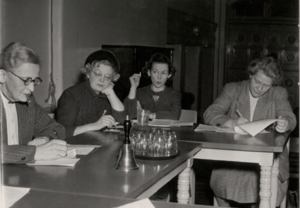Anna Westergaard facts for kids
Anna Westergaard (1882–1964) was a Danish railway worker and a very important activist for women's rights. She worked for the Danish State Railways and later became a traffic supervisor. She was also a leader in unions for railway workers and civil servants. Anna strongly believed that men and women should have equal rights in education and at work. She played a big role in the Danish Women's Society (1919–1924) and the Women's Council in Denmark (1938–1946). Westergaard spoke up for Danish women at the League of Nations in the 1930s. From 1937 to 1960, she was the president of Open Door International, an organization that worked for women's economic freedom. In politics, she was part of the Danish Social Liberal Party. She also served as a substitute member in the Upper House of the Danish parliament from 1939 to 1953.
Contents
About Anna Westergaard
Anna Westergaard was born on June 8, 1882, in Aarhus, Denmark. Her father was a dentist. In 1889, she passed a special exam. After that, she started a new path working for the Danish Railways (DSB). She first worked as an assistant writer in Aarhus. In 1911, she became the first woman to pass the traffic exam. This was after she got hands-on training at a railway station. In 1925, she became a traffic controller. By 1929, she moved to a job in central management. In 1951, she was promoted to traffic supervisor.
Anna cared a lot about workers' rights. She was a member of the main committee for the Railways Union (1912–1928). She also served on the Civil Servants Union committee during the same years. From 1922, she was the editor of the Railways Union's newspaper, Vor Stand.
Fighting for Women's Rights
Anna's interest in women's rights came from her mother. Her mother, who was a pastor's daughter, had always stood up for herself. Anna became a key leader in supporting women's rights. She especially focused on helping women become financially independent. This meant getting good education and jobs outside the home.
She was an early supporter of equal pay for men and women. She helped Thora Pedersen in her work on a special committee in parliament. Because of their efforts, new laws were made in 1918 to improve things. At a meeting of the Danish Women's Society in 1918, Anna disagreed with the leaders. They were criticizing the women who had just been elected to the Danish parliament. Because of this, Gyrithe Lemche stepped down as leader. Julie Arenholt became the new chair. Anna Westergaard joined the main leadership committee (1919–1924). She also led the Gentofte-Charlottenlund branch of the Women's Society from 1929 to 1935.
Supporting Women in Business
In 1934, the Danish Women's Business Council was started. Anna Westergaard became its chair. This group helped women whose jobs were at risk just because they were women. For example, in the 1930s, some people unfairly said that women teachers were taking jobs from men. Anna also argued that if women could work without fear of being fired for getting married or having children, it would help society.
Anna always believed that women did not need special protection at work. She thought they should work under the same rules as men. In 1935, she gave an important speech at the League of Nations. Even though she wasn't officially representing Denmark, she said women didn't need protection. She believed they could work in the same conditions as men, even in mines or at night. In 1937, she officially represented Denmark in Geneva and shared her views again. That same year, she became president of Open Door International. This group was started in 1929 to support women in business. She led this organization until 1960.
Political Life
Anna was a member of the Social Liberal Party. She served on the Gentofte City Council from 1924 to 1933. In the 1930s, she led the Social Liberal Association in Gentofte. She tried to get elected to parliament several times but was not successful. However, she served as a substitute member in the Langstinget (Upper House) from 1939 to 1953. Anna also wrote for different newspapers and journals. She contributed to important books about women, like Den gyldne Bog om danske Kvinder (1941) and Dansk Kvinde i Dag (1942).
Anna Westergaard passed away on February 6, 1964, in Charlottenlund. She was buried in Ordrup Cemetery.


